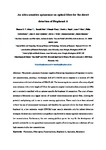An ultra-sensitive aptasensor on optical fibre for the direct detection of bisphenol A
| dc.contributor.author | Allsop, TDP | |
| dc.contributor.author | Neal, R | |
| dc.contributor.author | Wang, C | |
| dc.contributor.author | Nagel, DA | |
| dc.contributor.author | Hine, AV | |
| dc.contributor.author | Culverhouse, P | |
| dc.contributor.author | Ania Castañón, JD | |
| dc.contributor.author | Webb, DJ | |
| dc.contributor.author | Scarano, S | |
| dc.contributor.author | Minunni, M | |
| dc.date.accessioned | 2019-05-13T06:24:32Z | |
| dc.date.available | 2019-05-13T06:24:32Z | |
| dc.date.issued | 2019-06-15 | |
| dc.identifier.issn | 0956-5663 | |
| dc.identifier.issn | 1873-4235 | |
| dc.identifier.uri | http://hdl.handle.net/10026.1/13831 | |
| dc.description.abstract |
We present a plasmonic biosensor capable of detecting the presence of bisphenol A in ultra-low concentrations, yielding a wavelength shift of 0.15 ± 0.01 nm in response to a solution of 1 fM concentration with limit of detection of 330 ± 70 aM The biosensing device consists of an array of gold nano-antennae with a total length of 2.3 cm that generate coupled localised surface plasmons (cLSPs) and is covalently modified with an aptamer specific for bisphenol A recognition. The array of nano-antennae is fabricated on a lapped section of standard telecommunication optical fibre, allowing for potential multiplexing and its use in remote sensing applications. These results have been achieved without the use of enhancement techniques and therefore the approach allows the direct detection of bisphenol A, a low molecular weight (228 Da) target usually detectable only by indirect detection strategies. Its detection at such levels is a significant step forward in measuring small molecules at ultra-low concentrations. Furthermore, this new sensing platform paves the way for the development of portable systems for in-situ agricultural measurements capable of retrieving data on a substance of very high concern at ultra-low concentrations. | |
| dc.format.extent | 102-110 | |
| dc.format.medium | Print-Electronic | |
| dc.language | en | |
| dc.language.iso | en | |
| dc.publisher | Elsevier | |
| dc.subject | Plasmonics | |
| dc.subject | Fibre optics | |
| dc.subject | Nanostructures | |
| dc.subject | Bisphenol A | |
| dc.subject | Aptamers | |
| dc.subject | Biosensors | |
| dc.title | An ultra-sensitive aptasensor on optical fibre for the direct detection of bisphenol A | |
| dc.type | journal-article | |
| dc.type | Article | |
| plymouth.author-url | https://www.ncbi.nlm.nih.gov/pubmed/31004920 | |
| plymouth.volume | 135 | |
| plymouth.publication-status | Published | |
| plymouth.journal | Biosensors and Bioelectronics | |
| dc.identifier.doi | 10.1016/j.bios.2019.02.043 | |
| plymouth.organisational-group | /Plymouth | |
| plymouth.organisational-group | /Plymouth/Faculty of Science and Engineering | |
| plymouth.organisational-group | /Plymouth/Research Groups | |
| plymouth.organisational-group | /Plymouth/Research Groups/Marine Institute | |
| dc.publisher.place | England | |
| dcterms.dateAccepted | 2019-02-15 | |
| dc.rights.embargodate | 2019-5-25 | |
| dc.identifier.eissn | 1873-4235 | |
| dc.rights.embargoperiod | Not known | |
| rioxxterms.funder | EPSRC | |
| rioxxterms.identifier.project | Grating and waveguide plasmonic sensors | |
| rioxxterms.versionofrecord | 10.1016/j.bios.2019.02.043 | |
| rioxxterms.licenseref.uri | http://www.rioxx.net/licenses/all-rights-reserved | |
| rioxxterms.licenseref.startdate | 2019-06-15 | |
| rioxxterms.type | Journal Article/Review | |
| plymouth.funder | Grating and waveguide plasmonic sensors::EPSRC |


